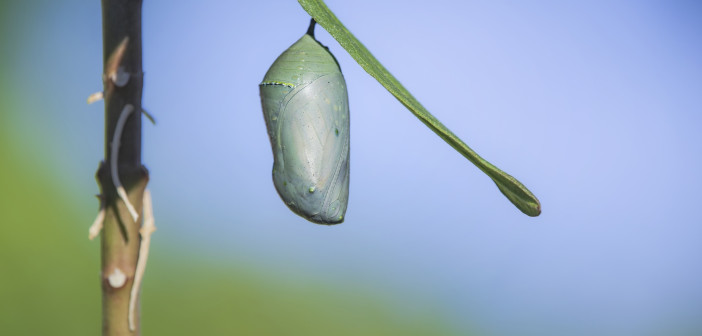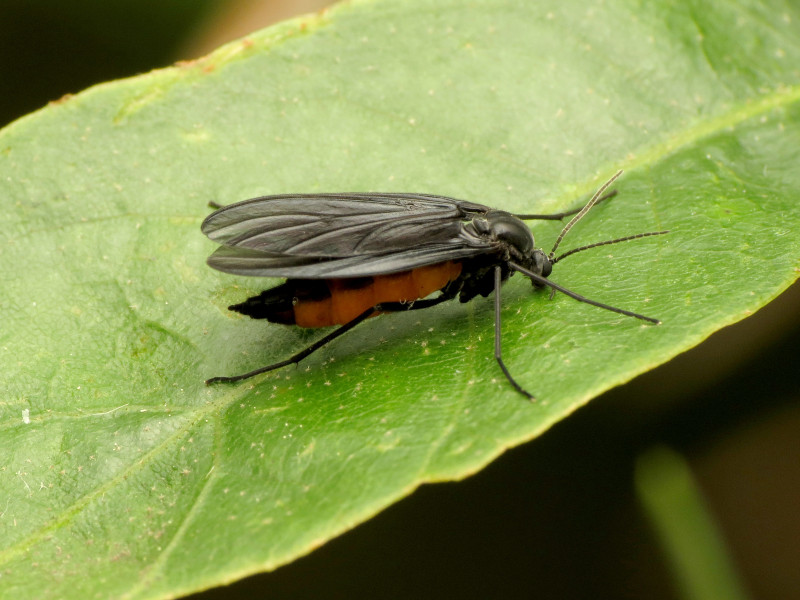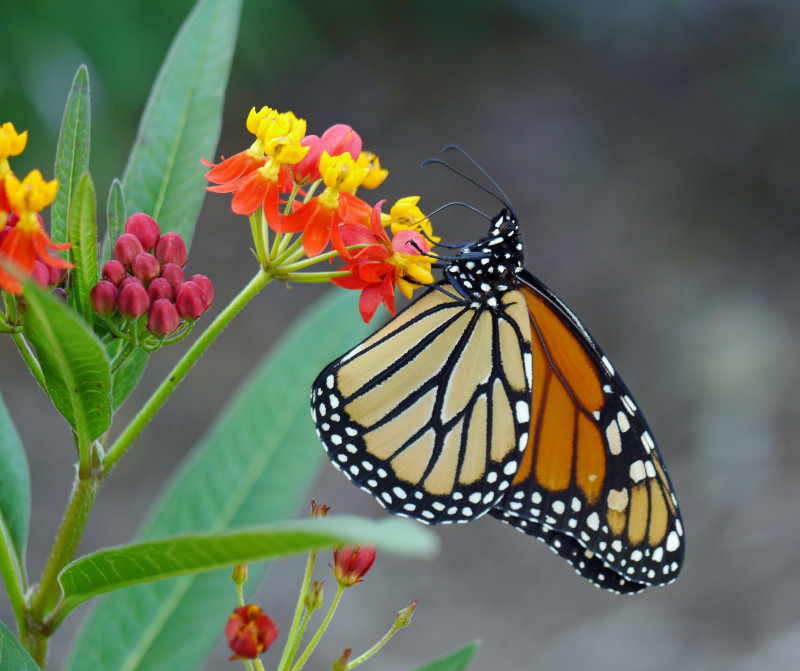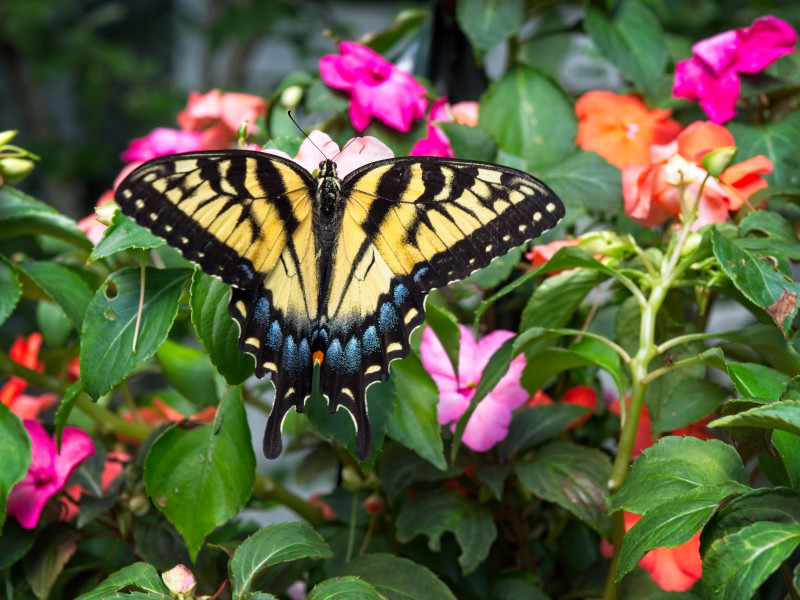“How does one become a butterfly?” she asked pensively.
“You must want to fly so much that you are willing to give up being a caterpillar.” – Trina Paulus, author
What keeps us from being skittish about butterflies? They’re insects, after all, like bees and hornets and those creepy June Bugs that sometimes crawl down our shirts in summer. Butterflies have six itchy-tickly legs with clawed feet, like cockroaches, and two antennae, like mosquitoes. They’re also related to horseflies, squash bugs, fire ants, and gnats. Jeepers!
The explanation, of course, is that they’re harmless and beautiful. Who hasn’t admired their bright colors and vivid wing patterns? Their graceful, lilting flight as they delicately touch each floret on an oh-so-sweet flower head and their flirtatious air dance with suitors?
Butterflies develop from caterpillars, which also creep some people out. Have you wondered how they go from that to the delightful insects we all love? Read on to find out just how miraculous it is to see a butterfly in your garden. It’s all about their life stages and the good fortune of surviving to adulthood through truly incredible odds.
Four stages of development
Butterflies go through four stages—from egg to caterpillar (larva) to pupa to winged adult. Many children have observed this in their classrooms. Adults, too, find that watching an adult emerge from its chrysalis is pretty thrilling.
First, the butterfly egg
Male and female butterflies find each other through visual cues, such as color, as well as pheromones, which are complex chemicals that signal they’re ready to mate. Males may use postures and flight patterns to show off their desirability.
Coupling occurs end to end, while in the air or on the ground, and may last only minutes or several hours. After that, the female searches for just the right kind of leaves to lay her eggs on (or sometimes, underneath). How she makes this determination is interesting: she can taste them with her feet! Depending on the species of butterfly, she might lay her eggs one at a time, several in a small cluster, or even hundreds at a time. Each egg sticks to the leaf because of a glue-like chemical that she secretes simultaneously. Eggs are at the mercy of a myriad of predators. These include:
-
- Ants: Many species of ants are known to eat butterfly eggs.
- Wasps: Parasitic wasps can lay their eggs inside butterfly eggs, and the wasp larvae consume the egg from within.
- Beetles: Certain beetles, such as ladybugs, also prey on butterfly eggs.
- Spiders can capture and eat butterfly eggs that are laid on or near their webs.
- Birds: Some small bird species may consume butterfly eggs if they find them on leaves or branches.
- Mammals: Small mammals, such as rodents, may inadvertently consume butterfly eggs while feeding on the foliage or flowers where the eggs are laid.
- Reptiles, amphibians: Lizards and frogs may also eat butterfly eggs if they come across them while foraging.
90 percent mortality!
In addition to these predators, environmental factors such as weather and habitat conditions can also impact the survival rate of butterfly eggs. It’s estimated that up to 90 percent of butterfly eggs may be lost to predation, parasitism, disease, and environmental factors before they hatch. This high mortality rate is part of why butterflies lay so many eggs, ensuring that at least some will survive to adulthood and continue the species.
If the egg survives, the developing larva (caterpillar) within is nourished by the yolk. When the right time comes, it gnaws through the shell and then usually eats its nutritious egg case as its first meal. After that, because of mom’s cleverness in selecting just the right “host” plant, its food will usually be right under its feet, ready for it to chow down on.
Larvae have an insatiable appetite and will grow ultimately to about 30,000 times bigger than they started! (You may have personally seen the large size of some of them; Black Swallowtail larvae, Papilio polyxenes, are examples. Their enormous appetite leads to a lot of defecation, unsurprisingly, but as full-fledged butterflies, they won’t poo at all. It seems as larvae, they did it all in advance! All larvae eat plants with the exception of one—the Harvester Butterfly, Feniseca tarquinius, which is carnivorous and eats Wooly Aphids, Eriosoma lanigerum. In fact, the female lays her eggs in the middle of aphid masses.
The butterfly larva (caterpillar)
The caterpillar’s body is composed mostly of intestines to quickly digest food, so food energy can be stored for the next stage of development. It puts on size very quickly over the course of two to four weeks. As it grows, however, it eventually butts up against the maximum its skin is able to expand. So, its response is to shed (molt) the too-tight skin. Once its new skin is freshly exposed, the larva puffs itself up by swallowing a lot of air and holds it until the new skin has hardened. After that, Voilà! it has room to grow larger under its new skin. This process occurs several times during this stage of development (each molt is called an instar, i.e. the first instar, second instar, etc.)
Butterfly larvae have other physiological peculiarities, too. They have a motherlode of eyes—six of them. But alas, they’re simple eyes called ocelli and can’t form images, only discerning the intensity of light. And, like other insects, they don’t have lungs. They breathe, instead, through pores (spiracles) in their abdomen and thorax. They have a brain and heart and can hear (Monarch Butterfly larvae reportedly react to loud noises). Regarding touch, the larvae sense through tiny hairs (setae) all over their body, something like the sensation we feel if something brushes across, say, the fine hairs on our arms.
Legs, legs, and more legs
Butterfly larvae have two types of legs—thoracic and prolegs. The thoracic legs, six of them, are, as the name implies, attached to the thorax (the body section located behind the head, equivalent to what we would call a human’s back). These legs are jointed and, later on, become the legs of the adult butterfly. But for now, they will be used to hold food.
The prolegs, on the other hand, serve a temporary purpose, that of climbing. There are five pairs, short and stubby and fitted with small hooks called crochets. With these, a larva can grasp a stem or leaf and move in any direction, including straight up.
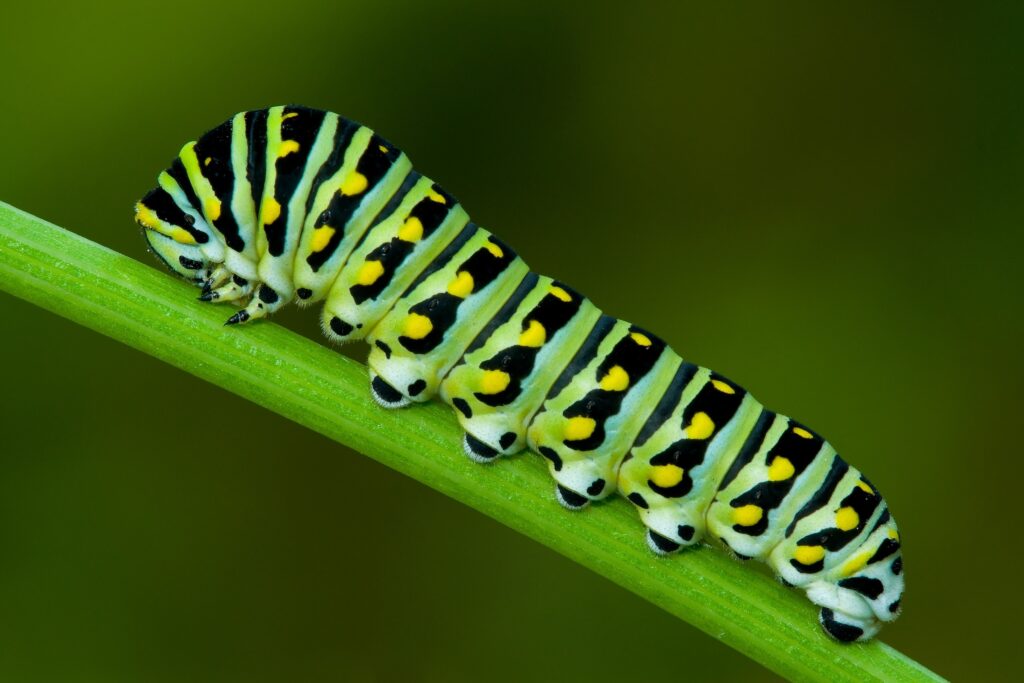
Black Swallowtail larva, Papilio polyxenes (© Tyler Fox / Shutterstock)
Some larvae have developed defenses. The Monarch we all love so well is one of them. Their larvae are poisonous, offering them protection from predators. And larvae have other tactics, too. Some are the same color as their host plant, others resemble bird droppings, and some have two large spots on their head that resemble eyes, giving predators the impression they’re snakes. Some larvae give off a foul odor that discourages parasitic wasps and flies.
The butterfly pupa
It’s estimated that 20 to 40 percent of butterfly pupae don’t survive due to all the reasons stated above. The pupa stage follows the last instar of the larva, and from it emerges the most mysterious and dramatic transformation: the winged butterfly. At this stage, the larva has eaten its fill, grown to a huge (relative) size, attached itself with silk thread to a branch or other support, and hardened its outer skin (this skin is now called a chrysalis). Almost all butterflies move some distance away from their host plant before entering this stage.
The larva, now referred to as a pupa, is mummy-like, seemingly at rest. But, within the chrysalis, it’s actually undergoing an energetic transformation. Some of the organs used by the larva disappear, new ones form, and others change. With many species, the chrysalis will become transparent just before the adult butterfly emerges, and you can see the fully formed adult, wings folded, legs folded, awaiting the moment of its “birth.” When it happens, it’s very fast. Within seconds, the head end of the chrysalis splits open, and the adult emerges.
Complete metamorphosis – the winged butterfly adult
So very fragile, it’s wet, and its wings are soft, not yet hardened into the stiff wing structure they’ll become. Now freed from the confinement of the chrysalis, the wings are free to expand. The butterfly pumps a fluid it has been storing in its body out into its wings, giving them form. This is the same principle as putting air in a balloon; until it’s inflated, it won’t hold its shape.
The moments after the new adult emerges are critical. If leaves, branches, or other obstructions prevent it from extending its wings their full width and length while they’re still wet, they will dry misshapen. A slight malformation may not prevent it from becoming a flying insect, akin to walking with a limp. But a serious one leaves it doomed—unable to fly, unable to access the nectar plants it needs to feed from, and easy prey. This is the fate of billions of butterflies and moths every year.
The first thing the adult wants to do is dry its wings. It’ll open and fold them many times over the course of an hour or two. Once dry, it’ll flap its wings, lift off with grace and ease, knowing exactly what to do, and catch a wind current to ride into its future. Only 10 percent of butterflies survive to this stage, and even as adults, they’ll face heavy predation, extreme weather conditions such as temperature fluctuations, heavy rains, or prolonged droughts, habitat destruction, pesticide use, and pollution.
Male or female?
You can sometimes tell male and female butterflies apart.
-
-
- Size: Females are often larger and less slender than males.
- Wing shape and markings: Males of some species have distinct wing shapes or additional markings. The Zebra Swallowtail, Eurytides Marcellus, is an example.
- Behavior: Females are often seen laying eggs on host plants, while males are more likely to be seen patrolling territories or engaging in courtship behaviors.
- Coloration and patterns: Females may have more subdued colors or different patterns, or they may be less pronounced. Males often have brighter colors and more striking patterns to attract females or ward off rivals.
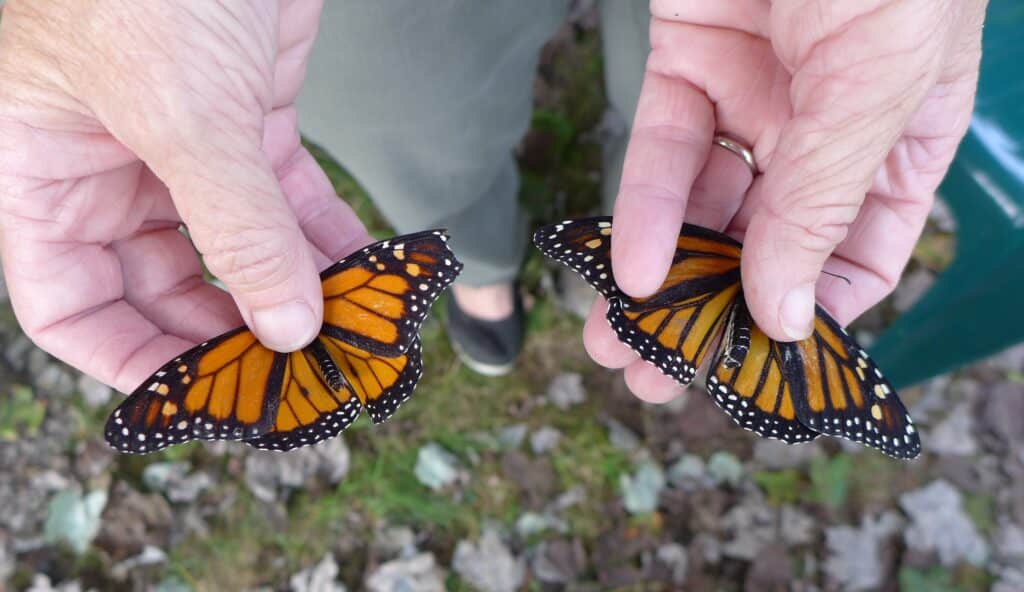
Monarch Butterfly, Danaus plexippus, male (L) and female. Notice the two dark spots and more veins on the male’s wing. (Kate St. John / Flickr; CC BY-NC-SA 2.0) copy
Food sources
Some butterfly species feed minimally or not all as adults and their lives are devoted exclusively to reproduction. Most, however, feed on flower nectar, sipping it through their tube-like tongue, called a proboscis. The proboscis is tightly curled when not being used; when extended, it might be as long as its body or longer.
Some adults sip from tree sap, rotting fruits, and even, oh my!, bird droppings or animal dung (and here we thought they were such elegant creatures.) Adults also drink water. You’ll sometimes see a gathering of them around a shallow depression holding water or even a mud puddle. What with all the sap and water, you’d think they would need to urinate, but they don’t. (Well, actually, they can eliminate if they drink too much water and simply must go, by emitting a fine spray of almost pure water from the tip of the abdomen.)
Some butterflies and moths make clicking sounds as a show of aggression when protecting an important nectar source they call their own. The Gossamer Wings family of butterflies makes these sounds to attract ants in one of nature’s displays of symbiosis; the ants, in turn, protect the butterfly.
All beauty and no brains?
Is Lepidoptera just pretty wings and graceful flight? Researchers don’t think so. It seems there are brains behind that beauty. Experiments with butterflies have shown they can be quickly taught to associate colors with a tasty reward. Not only that but also to keep two learned colors in mind—one they learn to associate with food and another they associate with egg-laying spots. Research also shows they quickly learn from a little trial and error to distinguish between old, faded blooms and bright, fresh ones by the differences in color.
According to researcher Dave Goulson, there has even emerged an “Einstein of butterflies.” It seems
Heliconius species (tropical butterflies that like to follow the same food route every day) remembered where in their route they were captured by researchers. For several days after their release, they avoided that spot but continued to follow the rest of their route. (
Heliconius also eats pollen, the only butterfly known to do so.)
Read about Heliconius spp.
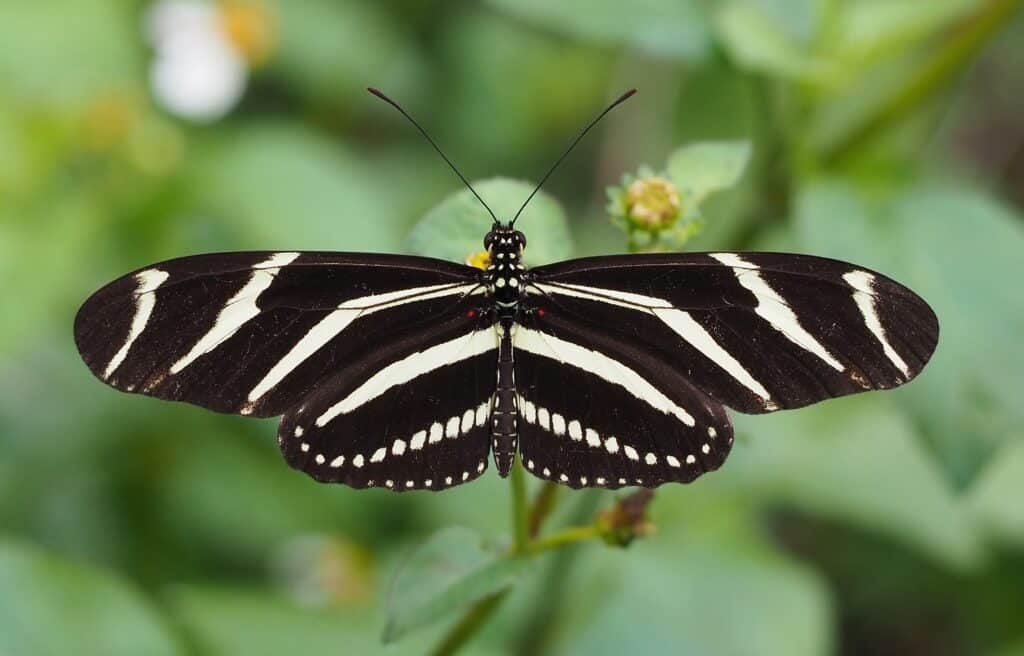
A Heliconius sp., the Zebra Longwing Butterfly, Heliconius charithonia, inhabits the U.S. (Nosferattus / Wiki; PD)
The rest of the story
On average, a butterfly’s adult lifespan is two weeks or less, although some tropical species have about six months, and species that overwinter as adults have a lifespan of about a year. There reportedly is one species, Yucca baccata, that spends thirty years as a caterpillar and pupa before emerging as an adult.
Like reptiles, Lepidoptera are cold-blooded. They require the sun to warm them. Look around on a summer morning, and you’ll see them at their stillest, basking on a rock or the surface of a leaf, soaking up the heat they need to warm their body and wings. You might even see them rapidly shivering their wings to warm up their muscles faster.
Like us, their limbs don’t function as efficiently when their muscles are cold. They don’t want to get too warm, though—they’ll head for the shade or sit under a leaf during the hottest part of a hot day.
But how do they solve the problem of winter weather? Some migrate to a warmer climate like the Monarch; some overwinter as eggs, caterpillars or pupa. Others, as adults, tuck themselves into nooks and crannies for the winter. There they hang in a state of diapause, or physiological dormancy, where their bodily functions are minimal. An anti-freeze-like substance produced by their body keeps them from freezing.
Why are they “butter”flies?
No one is sure how butterflies came to be called by that name. One story is that it’s a contortion of the words “flutter by.” Another is that witches transformed themselves into the shape of these insects and stole butter and milk. And there’s a possible explanation that they appeared in springtime when cows started producing milk for their newborn calves. These flying bugs were named butterflies because they would fly around while milk was churned into butter.
Butterfly folklore
A Sumatran fable tells the story that wives are sent down from the heavens, fully grown, emerging from butterfly eggs. In Madagascar, the Malagasy people have myths that connect human origins to butterflies. One such myth tells the story of a beautiful butterfly that transforms into a human being, symbolizing the beginning of the human race. In both cultures, the butterfly is more than just an insect; it is a powerful symbol of life, transformation, and ancestral heritage.
The Pima (Akimel O’odham) tribe of North America has a rich collection of myths and legends. One of their fables involves the creator god Chiowotmahki (sometimes spelled Chehooit or Szeukha), who took the form of a butterfly to embark on a journey to find a suitable place for humans to inhabit.
In Serbian folklore, butterflies are often associated with the souls of witches. The belief is that a witch can send her soul out of her body in the form of a butterfly. If someone finds the witch’s body while her soul is in butterfly form and turns it around, the soul (butterfly) will not be able to find the mouth to reenter the body, causing the witch to potentially die. This concept reflects a deep connection between butterflies and the supernatural, viewing butterflies as manifestations of spiritual or magical entities.
In Mexico, the butterfly is linked to the Day of the Dead celebrations, symbolizing the return of ancestors’ souls.


